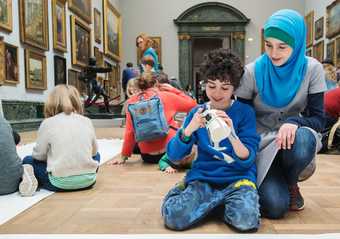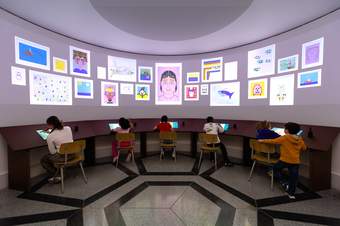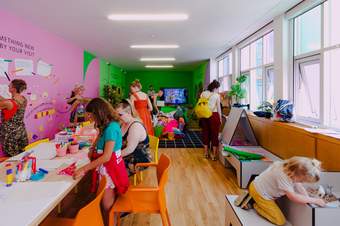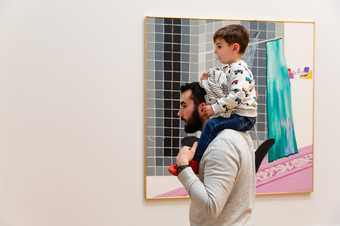
© Rikard Österlund
Where do we start?
When you visit Tate Britain you can learn about the story of British art from 500 years ago to the present. Have a go at finding these great artworks on your trip, and see what else you discover along the way. These are starting points to help you plan your visit as a family. Have fun and share your favourites with us on social media using #TateKids.
For more information about where to eat, drink and relax while you're here, read our top tips for visiting Tate Britain as a Family. Download our map [851 kb] to help find your way.
1. See Double
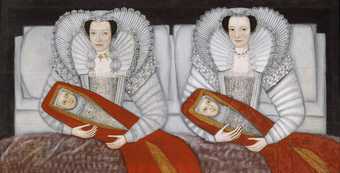
Unknown artist, Britain
The Cholmondeley Ladies
(c.1600–10)
Tate
Where is it? 1545 Room, Walk through British Art, Main Floor
This is a painting by an unknown artist, painted over 400 years ago. Look closely at the two women in the painting. They are sitting up in bed, fully dressed. When you first see the painting, you might think the pair of women and the pair of babies look the same.
What differences can you find between them? Look closely at their eyes, clothes and jewellery.
Do you think the Cholmondeley ladies were pleased with their portrait?
2. Imagine a future
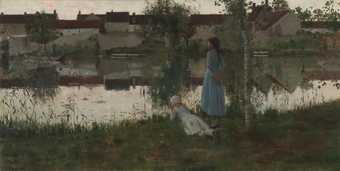
William Stott of Oldham
Le Passeur (The Ferryman) 1881
Where is it? 1812 Room, Walk through British Art, Main Floor
Le Passeur (The Ferryman) was painted in 1881 by British artist William Stott of Oldham in Grez-sur-Loing, an international artists' colony in north central France. Depicting two young female figures at dusk, the subject of the work might refer to Charon, the ferryman of Greek mythology who crosses the river Styx.
Spend some time looking at and thinking about this artwork. Imagine you are on the banks of the river gazing across the water...
What do you think the figures are looking at? What might they be thinking about? How would you describe the mood of this painting? Does it affect your mood?
Hear two young women from London talk about childhood and their dreams for the future inspired by this artwork - Sonic Trail: The Crossing (produced by Gaylene Gould and Ain Bailey with the Early years and Families team).
3. Make An Assemblage
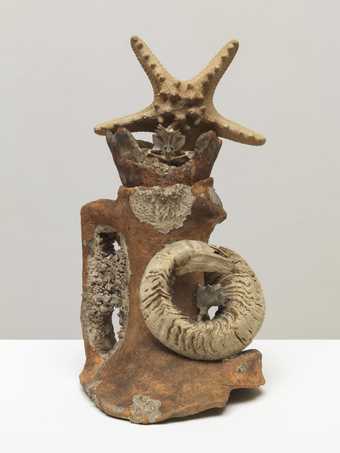
Eileen Agar
Marine Object
(1939)
Tate
Where is it? 1920 Room, Walk through British Art, Main Floor
Take a walk around this artwork and view it from different angles and heights.
What’s it made of? Where do you think the objects were found?
Artist Eileen Agar did lots of travelling by the sea and in the countryside, looking out for interesting objects and items from nature. This assemblage is made from objects she collected at different times in different places.
Can you make an artwork with objects you find today? What title will you give it?
Learn more about Eileen Agar on Tate Kids
4. Devise A New Language
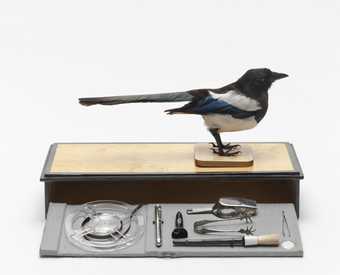
Rose Finn-Kelcey
The Magpie’s Box
(1977)
Tate
© Estate of Rose Finn-Kelcey, Courtesy the Estate and Kate MacGarry
Where is it? A Walk Through British Art, Main Floor.
Inspect this sculpture as closely as possible. What do you recognise, what do you think the objects could be used for?
The Magpie’s Box relates to a two-day performance by artist Rose Finn-Kelcey - made with two magpies in the window space of Acme Gallery, London in 1976. During the performance, Finn-Kelcey spent her time talking to the pair of magpies, offering them food and objects.
She commented: ‘I wanted to talk about the potential for another language, apart from the existing one that we tend to feel is the only one… and through that talk about a potential for women having a voice’.
How do you communicate everyday? Can you think of another form of communication you would like to use?
Try inventing a new language and think about what you want to communicate. You could try using words differently, or communicate through body and hand gestures, or maybe even objects. Perform your new language in the galleries!
5. Express Yourself
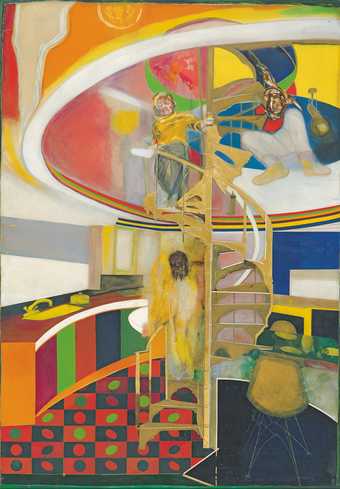
Frank Bowling, Mirror 1964–6, oil paint on canvas, 310 x 216.8 cm
© Frank Bowling. All Rights Reserved, DACS 2019, photo: Tate Photography
Where is it? 1960 Room, Walk through British Art, Main Floor
Take a good, long look at this painting and talk about what you notice, including the range of colours and patterns.
The staircase in this painting is modelled on one from the Royal College of Art, where Bowling studied. The artist depicts himself twice in the painting – at the top and bottom of the staircase - as someone who feels caught between two worlds. Despite early success, the artist had reason to feel excluded and this work can be seen as an expression of the resulting frustration.
Can you think of a time you felt excluded and frustrated? What kind of art medium would you choose to express yourself? Give it a try!
Learn more at Tate Kids about Frank Bowling here.

